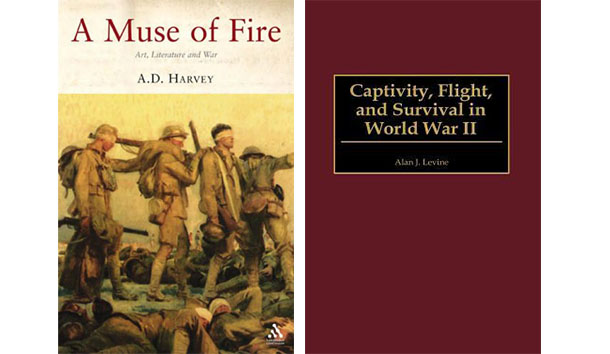A. D. Harvey’s study of art and war, while noting the suffering caused by the European wars of the 19th and 20th centuries, highlights the artistic and spiritual creativity released by these struggles. He regards the Great War, unlike World War II (which produced for the most part “tired accents”), as an exhilarating contest, which poets and artists ran to join. Harvey piles up the names and literary works associated with that war and shows that it spurred not only wartime creativity but a postwar culture shaped by military participation. The memorable literature that distilled the wartime experience did not simply rehash the propaganda of the belligerents; instead, it treated the struggle as a purifying or ennobling event without demonizing the enemy. Harvey makes his point by adducing the work of, among many others, Ernst Jünger, Siegfried Sassoon, and Wilfrid Owen, all of whom experienced the agony of trench warfare on the Western front.
What Harvey, who had family on both sides of World War I, does not fully recognize is that some writers had understood what might happen in 1914 and had desperately argued against the European collision. Among the Cassandras of the time were the Habsburg loyalist and dramatist Hugo von Hoffmansthal and Italian novelist and playwright Luigi Pirandello. Both admired the pre-1914 European civilization, had social and cultural affinities with the Latin and Germanic worlds, and perceived World War I as an internal European struggle that had to be avoided at all costs. Pirandello’s novelette, Berecche e la Guerra, though published in 1934, describes his horrified reactions to World War I. As an Italian educated in Germany with family members drafted into (and dying in) both the Italian and Austrian armies, Pirandello never recovered from what he saw as “il salto nella caligine della preistorica“—Europe’s leap backward into the darkness of prehistoric times.
As the newly appointed editor of the Salisbury Review, Harvey may now be a certified right-winger. Alan J. Levine remains a self-described FDR and Truman Democrat, albeit one whose loyalties shifted to the Eisenhower-Dulles administration after 1952. Although Levine writes mostly military-diplomatic and military technological histories, his predilections and dislikes do come through. Acheson, Truman, Churchill, FDR, Eisenhower, and MacArthur fare well in his work, while the America Firsters are treated as insular and silly, though not malevolent. I might describe Levine as a conventional Cold War liberal, except for two distinguishing marks: First, he expresses no strong dislike for World War II isolationists, though he thinks they were wrong in their assessment of the Nazi danger. (Levine wrote a scathing review in The World and I of Pat Buchanan’s commentary on American interventionism during World War Two, yet his remarks do not suggest any scorn for the author. Rather, he has expressed regret to me that an honorable public figure, who speaks courageously about immigration, would venture into scholarly matters exceeding his competence.) However, he despises those who were soft on the Soviets. As Levine points out, pro-Soviet “appeasers” were not simply misguided patriots who, like Charles Lindbergh, rallied to their country once it was at war. Western apologists for the Soviets, as portrayed by Levine, were predominantly sympathetic to a genocidal, totalitarian enemy. While he has nothing but condescending contempt for Joe McCarthy, Levine treats some anti-anti-McCarthyites, particularly James Burnham, with enormous respect.
Second, while Levine approves of some New Deal innovations, he cannot find much good to say about the subsequent changes in American polities and culture. Never in the narrative does Levine show the slightest deference to the Zeitgeist. He frequently identifies concentration-camp commandants and torturers as homosexuals and lesbians, and praises non-leftist Christians who helped persecuted Jews. His characterizations, based on the testimony of concentration-camp inmates, are correct. But they do offend against the prevailing establishment ideology, together with its peculiar form of holocaust revisionism.
Levine examines the escapes from inhuman wartime prisons in Europe and Asia; he stresses the difficulty of these feats for those who carried them out. In doing so, he avoids two equally erroneous misrepresentations that have been fashionable at different times: that camp inmates were totally passive in the face of their destroyers; and that they repeatedly engaged in dramatic and heroic revolts. Although Levine shows that breakouts from Treblinka and Sobibor did occur late in 1943, and occasional escapes were made from Auschwitz and Theresianstadt, he emphasizes that these were exceptional occurrences involving, at most, a few hundred inmates, the majority of whom subsequently perished. For Levine, wars are always grim. The virtues he associates with war are persistence in pursuing a reasonable strategy and the steady management of fortune; his warrior heroes—Eisenhower, Nimitz, and Rommel—were careful planners who always provided for contingencies.
Though some of the differences between Harvey’s celebration of martial virtue and Levine’s restrained admiration of efficiency may lie in the periods themselves, others might reflect the difference between a rooted conservative’s love of country and the rootlessnes of a New Deal liberal.
[A Muse of Fire: Literature, Art, and War, by A.D. Harvey (London: The Hambledon Press) 326 pp., $45.00]
[Captivity, Flight, and Survival in World War II, by Alan J. Levine (Westport, CT; Praeger Press) 258 pp., $67.50]

Leave a Reply